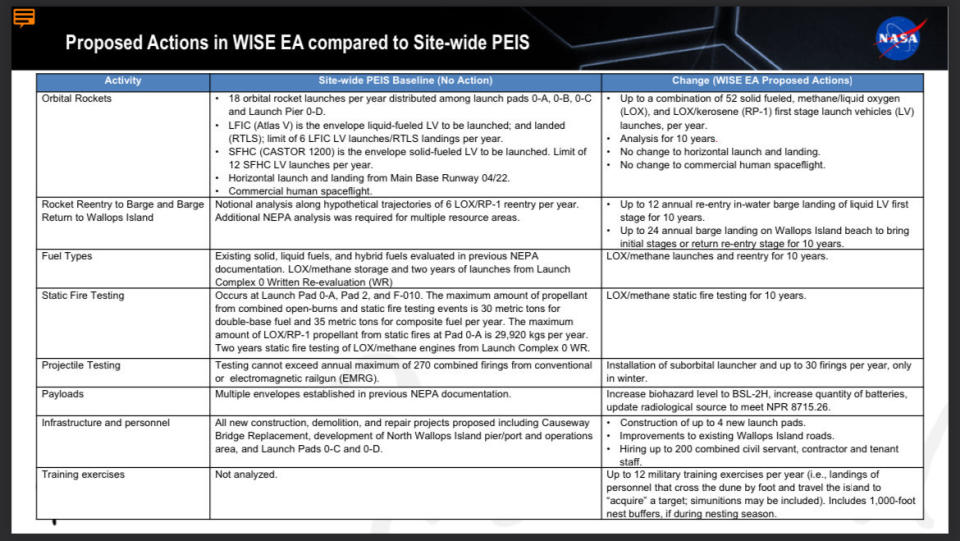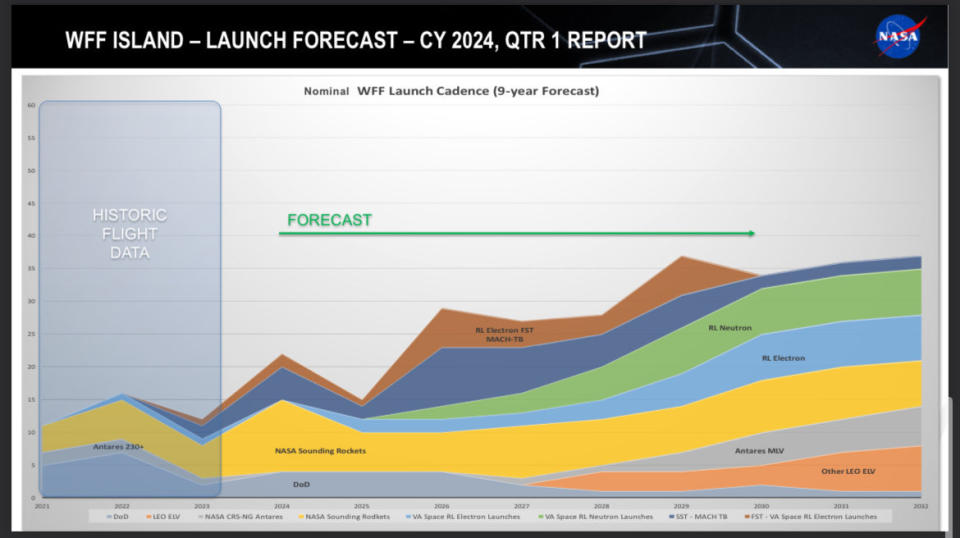NASA is expanding its Wallops Island facility to support three times as many launches
NASA is kicking off a formal environmental assessment of its facilities on Wallops Island, Virginia, to increase the number of authorized rocket launches at the site by almost 200%, according to slides and recordings of an April 29 internal meeting viewed by TechCrunch.
The proposed changes could help ease congestion at the country’s other spaceports, which have felt the strain of a rapid increase in launch capacity due primarily to SpaceX. That strain is projected to only worsen as companies, including Rocket Lab, Relativity, Blue Origin and others, aim to bring new rockets online in the next few years.
Wallops expansion has likely been on the minds of NASA officials for some time. After Rocket Lab conducted its first Electron launch from there in 2022, agency officials told the media that interest from private companies looking to launch from the site was “high.” And while these plans would eventually be made public as part of the EA process, this is the first time the scale of the proposed changes has been published.
The Wallops Island Southern Expansion Environmental Assessment (WISE EA), as the agency calls the undertaking, will study the potential consequences of a massive increase in annual launches from 18 to 52. The study will also consider other critical changes to the site, like water barge landings of rockets' first stages and on-site storage of liquid methane, a novel rocket fuel. To fully understand the effects of these changes, NASA will be working with contractors who will conduct acoustic analyses and look at air emissions impacts and impacts to marine and local wildlife.
The analysis will also consider the construction of up to four new launchpads and the installation of a suborbital launcher conducting up to 30 firings per year.
The increase in launches and new fuel mixes allowed are particularly notable. Today, of the 18 annual launches authorized at WFF, only six can involve liquid-fueled rockets, with the other 12 being solid-propellant rockets. The engines that power Electron, Rocket Lab’s launcher that flies out of Wallops, use a combination of liquid oxygen and RP-1, a highly refined kerosene.
The new analysis would authorize 52 launches per year and allow a fuel mix that also includes methalox, a rocket fuel composed of liquid oxygen and liquid methane. Methalox has become the propellant system of choice for next-gen rockets, including SpaceX’s Starship, Rocket Lab’s Neutron, Relativity Space’s Terran R and Blue Origin’s New Glenn.

A slide showing proposed changes. Image Credits: TechCrunch (screenshot from NASA)
One driver of the proposed expansion is the increased launch cadence from these companies. (While Relativity has not publicly disclosed any plans to launch from Wallops, the company, along with Rocket Lab, were listed as the two “participating agencies.”)
The Wallops site has become particularly important to Rocket Lab’s plans to bring Neutron to market by the end of this year. In 2022, the company announced it had selected Wallops Island as the future home for Neutron’s first launchpad and production facility, effectively staking a claim in the future of the island. Rocket Lab’s recovery plans for Neutron also include the booster landing on downrange, on a barge at sea.
One of the slides in Miller’s presentation shows a launch forecast for WFF through 2032. It is unclear whether the data on the slide was provided by private companies or whether it's from NASA’s internal estimates, and NASA did not immediately respond to TechCrunch’s request for comment, but it charts around five annual Neutron flights per year through 2030. It also charts about five launches of Firefly and Northrop’s MLV by that date.

Image Credits: TechCrunch (screenshot from NASA)
Environmental assessments are essential: They ensure NASA and its commercial partners are following environmental regulations related to air emissions, acoustic impacts, and effects on local wildlife. They also provide a critical venue for input from stakeholders, including the public. Having an environmental assessment in place is vital for companies like Rocket Lab, as well as Firefly Aerospace and Northrop Grumman, which are together developing a medium launch vehicle.
NASA completed a programmatic environmental impact statement (PEIS) for the Wallops site in 2019, but as agency official Shari Miller said during the call, the anticipated growth of activity on the island “exceeds the numbers that were analyzed” for that document. Some proposed actions weren’t discussed at all in the 2019 document, like a water barge landing of a rocket. Miller said NASA is simultaneously undertaking what’s known as a “written re-evaluation” of the 2019 assessment to understand if additional environmental assessments is needed to allow for the storage of liquid methane and to authorize static fire tests of methalox engines at WFF. That would authorize those actions for two years, and importantly, act as a sort of temporary measure to facilitate Rocket Lab’s rollout of Neutron. The full WISE EA would extend for a full 10 years.
Because of the scope of the various environmental assessments, the full EA process is projected to take around 18 months, per one slide, with the final document published in December 2025.

